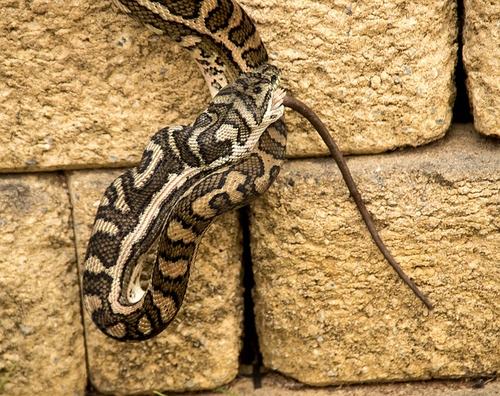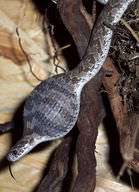16.27 蛇 - 高级
章节大纲
-
How did this occur?
::怎么会这样?Here we have a python devouring a small rodent . Obviously, the rodent is big compared to the size of the snake's mouth. So how did the rodent end up inside the snake? The python must be able to open its mouth fairly wide.
::我们这里有只虫在吞食一只小老鼠。显然,与蛇嘴的大小相比,老鼠是很大的。那么,老鼠怎么会在蛇里?它必须能够张大嘴。Snakes
::蛇蛇All snakes are carnivorous and can be distinguished from legless lizards by their lack of eyelids and external ear openings, as shown in Figure . The 2,900 of snakes live in every continent except Antarctica. Snakes range in size from the tiny, 10 cm long thread snake to pythons and anacondas, which can grow to over 7 meters long.
::如图所示,所有蛇都是食肉性蛇,可以与没有腿的蜥蜴区别开来,因为它们缺乏眼皮和外耳开口,如图所示。除南极洲外,每个大陆都有2 900条蛇。 蛇的大小从小的10厘米长长的蛇、长10厘米长的蛇,到可以长到7米长的蛇和蚂蚁。This red-tailed boa (B. c. constrictor) has typical snake features. Snakes do not have eyelids or external ears, two features that distinguish them from lizards (compare the snake’s eye to the eye structure of the anole in the Reptiles: Squamata concept). You can also see the keratin scales that are extensions of the snake’s epidermis. Snakes have been around for a long time. They may have evolved from lizards that adapted to burrowing underground during the Cretaceous period (about 150 million years ago). The diversity of modern snakes appeared during the Paleocene period, about 66 to 56 mya.
::在白鲸时期(约1.5亿年前 ) , 蛇已经存在了很长一段时间。 它们可能已经从适合地下钻洞的蜥蜴中演变而来。 现代蛇的多样性出现在帕莱辛(Paleone)时期,大约66到56米亚。Diet
::饮食All snakes are carnivorous; they eat small including lizards, other snakes, small mammals , , eggs , , snails, and . Because snakes cannot bite or tear their food to pieces, prey must be swallowed whole. The body size of a snake has a major influence on its eating habits. Smaller snakes eat smaller prey. For example, young pythons might start out feeding on lizards or mice and graduate to small deer or antelope as an adult.
::所有蛇都是食肉蛇;它们吃小的,包括蜥蜴、其他蛇、小哺乳动物、蛋、蜗牛和。因为蛇不能咬或撕碎食物,猎物必须全被吞掉。蛇的身体大小对其饮食习惯有重大影响。小蛇吃小猎物。例如,小蛇可能开始食用蜥蜴或小老鼠,并成年后变成小鹿或羚羊。Some snakes have a venomous bite, which they use to kill their prey before eating it. Other snakes kill their prey by constriction , in which they will suffocate their prey. Still others swallow their prey whole and alive.
::有些蛇有毒咬,它们用它来猎杀猎物,然后吃它。其他蛇则用收缩来杀猎物,它们用它来窒息猎物。还有一些蛇则用它来吞食它们的猎物,把猎物全部活吞掉。Venom in snakes is primarily for killing and subduing prey, rather than for self-defense. Venom is modified saliva that is delivered through fangs. The fangs of some venomous snakes, like vipers, are hollow in order to inject venom more effectively, while the fangs of other snakes, such as the boomslang, have grooves that channel venom into the wound. Snake venoms are often prey specific; its role in self-defense is secondary. Venom, like all salivary secretions, has enzymatic action. It starts the breakdown of food into smaller molecules, which allows for better digestion .
::蛇的毒气主要是用于杀死和征服猎物,而不是用于自卫。毒气是经过改良的唾液,通过牙牙传递。一些毒气蛇的尖牙,如毒蛇,是空的,以便更有效地注射毒液,而其他蛇的尖牙,如繁荣等,则有把毒液带入伤口的洞穴。蛇毒气往往是特定的猎物;它在自卫中的作用是次要的。毒气,如所有唾液分泌,都具有酶作用。它开始将食物分解成小分子,从而可以更好的消化。The snake's jaw is the most unique jaw in the animal . They have a very flexible lower jaw, the two halves of which are not rigidly attached, and numerous other in their skull. This flexibility allows a snake to open its mouth wide enough to swallow its prey whole, even if the prey is larger in diameter than the snake itself. For example, the African egg-eating snake, shown in Figure , has flexible jaws adapted for eating eggs that are much larger than the diameter of its head. This snake has no teeth, but it does have bony protrusions on the inside edge of its spine that are used to aid in breaking the shells of the eggs it swallows.
::蛇的下巴是动物中最独特的下巴。 它们有一个非常柔软的下巴, 下巴的两半没有紧紧的连接, 头骨上还有很多其他的。 这种灵活性允许蛇张开嘴, 吞下整个猎物, 即使猎物的直径大于蛇本身。 例如, 图中显示的非洲吃蛋的蛇, 具有适应于食用比其头部直径大得多的蛋蛋的柔软的下巴。 这个蛇没有牙齿, 但是它的脊椎内边缘确实有骨肉状, 用来帮助打破其吞咽的蛋壳。An African egg-eating snake (Dasypeltis spp.) that has just swallowed a whole egg. The egg will eventually get crushed by bony spikes that protrude from the spine. The snake then squeezes every last bit of liquid out of the inside of the egg before regurgitating the completely crushed egg shell. Digestion takes a lot of energy . A snake that has just eaten will rest quietly while it digests its prey. In species that feed only occasionally, the entire intestine is reduced between meals to conserve energy. When undisturbed, the digestive process is highly efficient; a snake's digestive dissolve and absorb everything but the prey's hair and claws, which are excreted along with waste. If disturbed while digesting, a snake will often regurgitate its food so that it can get away quickly.
::消化过程需要大量能量。 刚刚吃过的蛇在消化猎物时会安静地休息。 在只偶尔喂食的物种中,整个肠子在为节能而供餐之间会减少。 在不受干扰的情况下,消化过程会非常高效;蛇的消化过程会溶解并吸收除了猎物的头发和爪子之外的所有东西,它们会与废物一起被排出。如果消化过程中受到干扰,蛇会把食物重新配给食物,以便它能迅速离开。Sensory Organs
::感知器官Snakes have poor eyesight, but they can detect movement . is generally the best in tree-living snakes and worst in burrowing snakes. Some snakes have binocular vision, with both capable of focusing on the same point.
::蛇的视力差,但能探测到运动。 一般来说,蛇在活树的蛇中是最好的,在挖洞的蛇中是最差的。 有些蛇有望远镜的视力,两者都能关注同一点。Snakes use smell to track their prey. They smell by using their forked tongues to collect airborne particles, which they then pass to the Jacobson's organ , or the vomeronasal organ, in the mouth for examination. The fork in the tongue gives the snake a sort of directional sense of both smell and taste at the same time. The snake keeps its tongue constantly in motion, sampling particles from the air, ground, and , analyzing the chemicals found, and determining the presence of prey or predators in its local environment.
::蛇用嗅觉追踪猎物。它们用舌头收集空气中的颗粒物,然后将这些微粒传递给雅各布森的器官或口腔中的血管器官进行检查。 舌头中的叉子使蛇具有一种嗅觉和口味的定向感。 蛇的舌不断动动,从空中、地面和地面采样颗粒,分析发现的化学物质,确定当地环境中是否有猎物或捕食者。The part of the body which is in direct contact with the surface of the ground is very sensitive to vibration. Thus, a snake is able to sense other animals approaching by detecting faint vibrations in the air and on the ground.
::与地面表面直接接触的身体部分对振动非常敏感,因此,蛇通过在空气和地面探测微弱的振动,可以感觉到其他动物正在接近。Pit vipers, pythons, and some boas have infrared-sensitive receptors in deep grooves between their nostril and eye. Some snakes have pits on their upper lip, just below the nostrils (common in pythons). These heat-sensing pits allow the snakes to “see” the infrared radiation that warm-blooded animals emit. The heat-sensing ability of these snakes is very accurate. A blind rattlesnake can target vulnerable body parts of the prey that it strikes.
::毒蛇、皮克斯和一些野牛在鼻孔和眼睛之间的深角有红外线敏感感应器。有些蛇的上唇有坑,就在鼻孔下(常见的刺眼中 ) 。 这些热感应坑让蛇能够“看到”热血动物发出的红外辐射。这些蛇的热感应能力非常精确。一只盲目的响尾蛇可以瞄准它撞击的猎物的脆弱身体部位。Internal Organs
::内部机关内部机关The skeleton of a snake looks very different from other therapods. Its skeleton is essentially a skull attached to many vertebrae and ribs, as shown in Figure . Snakes do not have any leg , but remains of the pelvis are found in some boas and threadsnakes.
::正如图所示,蛇的骨骼与其他蛇头的骨骼大不相同。 它的骨骼基本上是连接许多脊椎和肋骨的骨骼。 蛇没有腿,但骨盆的残骸却在一些山脊和螺丝螺中找到。A snake skeleton. The snake’s many vertebrae give it great flexibility and a wide range of movement. In order to accommodate their narrow bodies, paired organs (such as kidneys) appear one in front of the other, instead of side by side.
::为了容纳狭窄的身体,配对的器官(如肾脏)在另一器官面前出现,而不是并排出现。As with all , snakes are poikilotherms. They have a three-chambered heart composed of two atria and one large ventricle . The snake’s heart is able to move around due to the lack of a diaphragm . This adaptation protects the heart from possible damage when the snake swallows large prey. The of snakes is also unique due to the presence of a renal portal system in which the from the snake's tail passes through the before returning to the heart.
::和所有情况一样,蛇都是大热。蛇有三组心脏,由两个亚特里亚和一个大腹肌组成。蛇的心脏能够移动,因为缺乏隔膜。这种适应性可以保护心脏免受蛇吞下大猎物时可能造成的损害。蛇的特性也是独特的,因为有肾脏入口系统,蛇的尾巴从蛇的尾巴穿透心脏,然后返回心脏。In the majority of snake species, only one lung is functional. The left lung is often small or sometimes even absent, as snakes' tubular bodies require all of their organs to be long and thin. Many organs that are paired, such as kidneys and reproductive organs, are staggered within the body, with one located ahead of the other, as shown in Figure .
::在大多数蛇种中,只有一个肺起作用,左肺往往很小,有时甚至没有,因为蛇管形身体要求所有器官长薄,许多配对的器官,如肾脏和生殖器官,在身体内交错开来,如图所示,一个位于另一端。The anatomy of a snake. Note how each of the snakes organs are long and thin (elongated) to fit inside its body. 1 esophagus, 2 trachea, 3 tracheal lungs, 4 rudimentary left lung, 5 right lung, 6 heart, 7 liver, 8 stomach, 9 air sac, 10 gallbladder, 11 pancreas, 12 spleen, 13 intestine, 14 testicles, 15 kidneys. Scales and Skin
::天平和皮肤The shedding of scales is called ecdysis. In the case of snakes, the complete outer layer of skin is shed in one layer. Snake scales are not discrete, but are extensions of the epidermis , and they are not shed separately. They are molted as a complete outer layer of skin, much like a sock being turned inside out. A snake will rub up against rough surfaces to peel the molting skin from its body. Molting serves a number of functions - firstly, the old and worn skin is replaced, and, secondly, it helps get rid of parasites such as mites and ticks.
::弧度的厚度被称作斜线。对于蛇来说,整层外层的皮肤被划成一层。蛇的宽度不是离散的,而是皮层的延伸,它们不是分开的。它们被划成完全的外层皮肤,就像一只袜子被划出来一样。蛇会用粗糙的表面摩擦,从身体上剥开撕裂的皮肤。熔化起到一些功能——首先,旧的和磨损的皮肤被替换,其次,它有助于除掉寄生虫,如墨水和虱子。Summary
::摘要-
All snakes are carnivorous; they kill their prey using venom or through constriction.
::所有蛇都是食肉蛇,它们用毒液或收缩杀死猎物。 -
A snake's skeleton is essentially a skull attached to many vertebrae and ribs.
::蛇的骨骼基本上是 与许多脊椎和肋骨相连的头骨 -
Many organs in snakes are staggered one in front of the other in order to fit into their elongated bodies.
::蛇体内的许多器官相互交错,以适应其长长的身体。
Review
::回顾-
What do snakes eat? How do they consume their food?
::蛇吃什么?它们怎么消费食物呢? -
What is the primary purpose of snake venom?
::蛇毒的主要目的是什么? -
Snakes have been known to regurgitate their food when pursued. Why do they do this?
::人们知道蛇在捕食时会重新给食物注入营养,为什么它们会这样做呢? -
How is the skeleton of a snake different from other therapod skeletons?
::蛇的骨骼 与其他的神器骨骼有什么不同? -
What is unique about a snake's circulatory system?
::蛇的循环系统有什么独特之处?
-
All snakes are carnivorous; they kill their prey using venom or through constriction.




